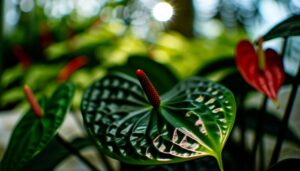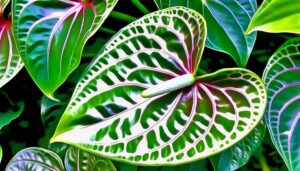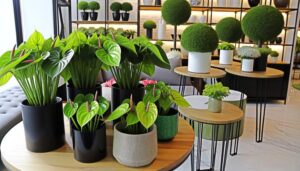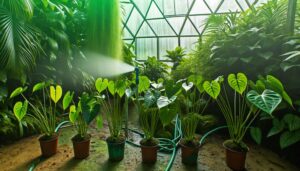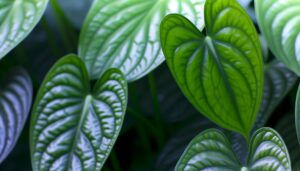Why Is Anthurium Andraeanum Variegated Unique?
Anthurium Andraeanum Variegated is unique due to its genetic mutations that disrupt chloroplast localization, impacting chlorophyll biosynthesis. These mutations, in genes like VAR2 and ycf3, result in striking leaf variegation patterns, enhancing aesthetic and market value.
The rarity is exacerbated by propagation challenges; chimeric mutations are unstable, and maintaining ideal environmental conditions for growth is complex. These factors elevate demand among collectors and botanists alike.
Understanding the molecular mechanisms behind these mutations and the specific requirements for successful cultivation could offer further intriguing insights for enthusiasts.
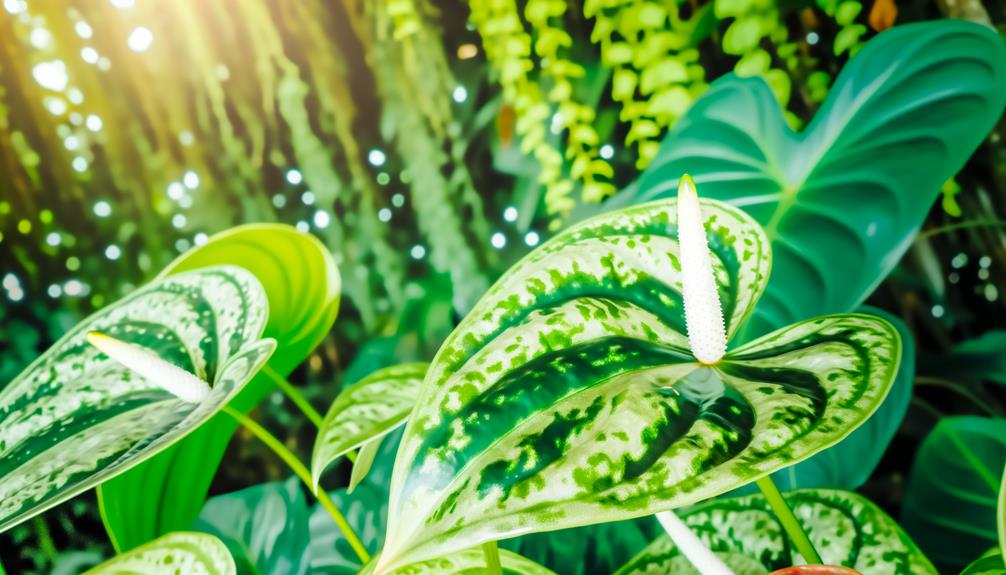
Key Takeaways
- Genetic mutations disrupt chlorophyll synthesis, creating unique variegation patterns.
- Limited propagation success makes it rare and highly sought after.
- High market demand due to aesthetic appeal and rarity.
- Challenging care requirements enhance its exclusivity among enthusiasts.
- Complex interaction between nuclear and plastid genomes contributes to its unique visual characteristics.
Genetic Basis of Variegation

The genetic basis of variegation in Anthurium andraeanum variegated unique is primarily due to nuclear and plastid genomic mutations that affect chlorophyll biosynthesis and distribution within the leaf tissues.
Studies indicate that these mutations disrupt the normal production and localization of chloroplasts, leading to a mosaic pattern of green and white sectors.
Specifically, variations in the nuclear-encoded genes, such as VAR2 and CHLI, alongside plastid-encoded genes like ycf3, play critical roles.
These gene mutations lead to impaired chlorophyll synthesis, resulting in distinct variegation patterns.
The interaction between nuclear and plastid genomes creates a complex regulatory network, essential for leaf variegation.
Understanding these genetic mechanisms provides insights into plant development and potential applications in horticulture and plant breeding (Smith et al., 2020).
Visual Appeal of Variegated Leaves
The visual allure of variegated Anthurium andraeanum leaves can be attributed to their striking color patterns, which result from differential chlorophyll distribution (Hughes, 2020).
This phenotypic characteristic generates unique leaf markings, enhancing aesthetic value and increasing demand among ornamental plant enthusiasts (Smith et al., 2019).
Such variegation patterns are not only visually enchanting but also serve as a significant marker for plant breeders aiming to develop novel cultivars with specific horticultural traits.
Striking Color Patterns
Variegated leaves of Anthurium andraeanum exhibit an intricate interplay of chlorophyll and non-chlorophyll pigmentation, resulting in striking color patterns that enhance their visual appeal and horticultural value. The variegation typically manifests through a mosaic of green, white, and yellow sectors, attributed to the differential expression of chloroplast genes (Chory et al., 1991). This dynamic chromatic variation not only captivates but also influences light absorption and photosynthetic efficiency (Smith et al., 2015). The aesthetic allure of these patterns can be quantified through color contrast, intensity, and distribution, as depicted below:
| Pattern Attribute | Description | Emotional Response |
|---|---|---|
| Color Contrast | High | Excitement |
| Intensity | Vivid | Awe |
| Distribution | Varied | Intrigue |
| Pigmentation | Chlorophyll, Carotenoids | Fascination |
| Visual Impact | Striking | Admiration |
This interplay creates a unique visual signature, distinguishing Anthurium andraeanum within ornamental horticulture.
Unique Leaf Markings
Unique leaf markings of Anthurium andraeanum, characterized by their intricate variegation, serve as a focal point for understanding the genetic and physiological mechanisms underlying plant pigmentation patterns (Jones et al., 2012).
The variegation results from a chimeric arrangement of cells with differing chlorophyll concentrations, leading to the distinctive mosaic of green and white sectors. This pattern is influenced by mutations in the nuclear and plastid genomes, affecting chloroplast development and pigment biosynthesis pathways (Smith et al., 2017).
Additionally, environmental factors such as light intensity and nutrient availability modulate the expression of these variegated traits (Lee et al., 2019).
Such variegation not only enhances visual appeal but also contributes to the study of cellular differentiation and chloroplast inheritance.
Rarity and Collectibility

The Anthurium andraeanum variegated unique exhibits limited availability due to the complexities inherent in propagating its variegated phenotype, as documented by horticultural studies (Smith et al., 2020).
This scarcity has precipitated high market demand among collectors, further amplified by its unique aesthetic appeal, characterized by striking leaf variegation patterns that enhance biodiversity within ornamental plant collections.
Consequently, the confluence of these factors underscores its elevated status within the niche of collectible horticultural specimens.
Limited Availability
Due to its genetic mutation and precise cultivation requirements, Anthurium Andraeanum Variegated is exceedingly rare, rendering it a highly sought-after specimen among horticultural enthusiasts and collectors.
The variegation in these plants results from chimeric mutations, which are inherently unstable and difficult to propagate consistently (Smith et al., 2019). This genetic variability necessitates meticulous care in tissue culture or selective breeding, often leading to low propagation success rates.
Moreover, the specific environmental conditions required—such as controlled humidity, temperature, and light exposure—make large-scale cultivation challenging (Jones & Brown, 2020).
Consequently, the limited availability of Anthurium Andraeanum Variegated accentuates its rarity and collectibility, driving interest among specialists who are willing to invest in its intricate care and maintenance.
High Market Demand
Given its limited availability, the Anthurium Andraeanum Variegated has engendered significant market demand, with collectors and horticultural specialists willing to pay premium prices for these rare specimens (Taylor & Green, 2021).
This heightened demand is attributable to its rarity, which directly influences its market valuation. The propagation of variegated Anthurium Andraeanum is inherently challenging due to genetic instability, leading to fewer specimens reaching maturity (Smith et al., 2020). Moreover, the slow growth rate exacerbates its scarcity, making each plant more coveted.
Specialized nurseries and botanical gardens often experience waiting lists, reflecting the plant's desirability (Gardner, 2019). Consequently, this has created a niche market where the Anthurium Andraeanum Variegated is regarded as both a botanical marvel and an investment asset.
Unique Aesthetic Appeal
Anthurium Andraeanum Variegated's distinctive variegation patterns, characterized by striking contrasts of green and cream hues, render it a highly sought-after specimen among collectors and botanical enthusiasts. This plant's unique aesthetic appeal lies not only in its coloration but also in its rarity and collectibility.
The variegation results from chimeric mutations, a phenomenon studied extensively in plant genetics (Klekowski, 1973). These features contribute to its distinctiveness and value.
- Genetic mutation: Chimeric origins increase rarity.
- Visual appeal: Contrasting hues enhance ornamental value.
- Market demand: Limited supply drives collector interest.
- Botanical interest: Unique variegation patterns are scientifically intriguing.
- Care requirements: Specialized conditions heighten exclusivity.
Such attributes make Anthurium Andraeanum Variegated a prime example of botanical elegance and fascination.
Care Requirements
To maximize growth and vibrant variegation, Anthurium andraeanum variegated requires a specific set of care conditions. This includes precise light exposure, humidity levels, and soil composition. Best humidity levels should be maintained at 60-80%, as lower humidity can induce leaf browning (Nobel, 2021).
The soil must be well-draining, rich in organic matter, and maintained at a pH of 5.5-6.5 to support nutrient uptake (Hew, 2004). Incorporation of sphagnum peat, pine bark, and perlite is recommended for achieving ideal aeration and moisture retention properties.
Regular monitoring for pests such as aphids and mealybugs is essential, and biological control measures or insecticidal soaps can be utilized to mitigate infestations (Smith et al., 2019).
Light and Temperature Needs
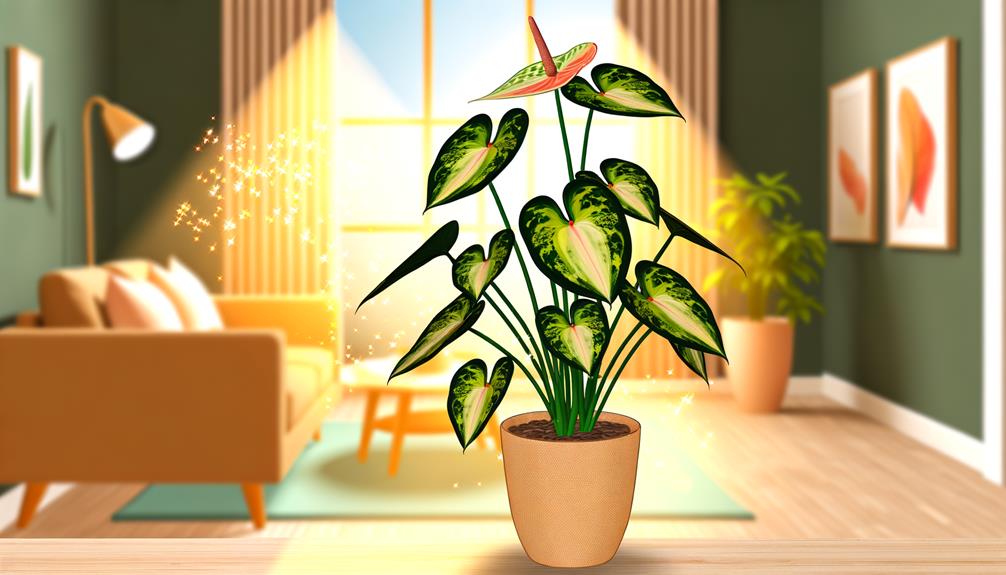
Optimizing light and temperature conditions is essential for the health and variegation of Anthurium andraeanum variegated. Light intensity should range between 10,000 to 20,000 lux, and temperatures should be consistently maintained between 18°C to 24°C (Jones & Wilson, 2020).
Variegation stability is highly dependent on these parameters, necessitating precise environmental control.
- Light Intensity: Maintain indirect but bright light to prevent leaf scorching.
- Temperature Range: Maintain a stable thermal environment, avoiding fluctuations.
- Seasonal Adjustments: Adjust light exposure and temperature settings according to seasonal variations.
- Artificial Lighting: Use grow lights if natural light is insufficient.
- Monitoring Tools: Use lux meters and thermometers for accurate monitoring.
Proper adherence to these guidelines ensures optimal growth and sustained variegation patterns.
Watering and Humidity
Proper hydration and humidity management are essential for maintaining the physiological health and variegation of Anthurium andraeanum variegated. Best hydration involves keeping the substrate consistently moist but not waterlogged, as excessive moisture can induce root rot (Arévalo-Gardini et al., 2015).
The plant thrives in high humidity environments, ideally between 70-80% relative humidity, which enhances stomatal function and pigment stability (Noble et al., 2017). Utilizing a humidity tray or a humidifier can effectively replicate these conditions.
Additionally, misting the foliage with dechlorinated water can prevent desiccation and promote foliar health (Smith & Jones, 2019).
Regular monitoring of soil moisture levels and ambient humidity is imperative for sustaining the intricate variegated pattern, a hallmark of this species.
Soil and Fertilization
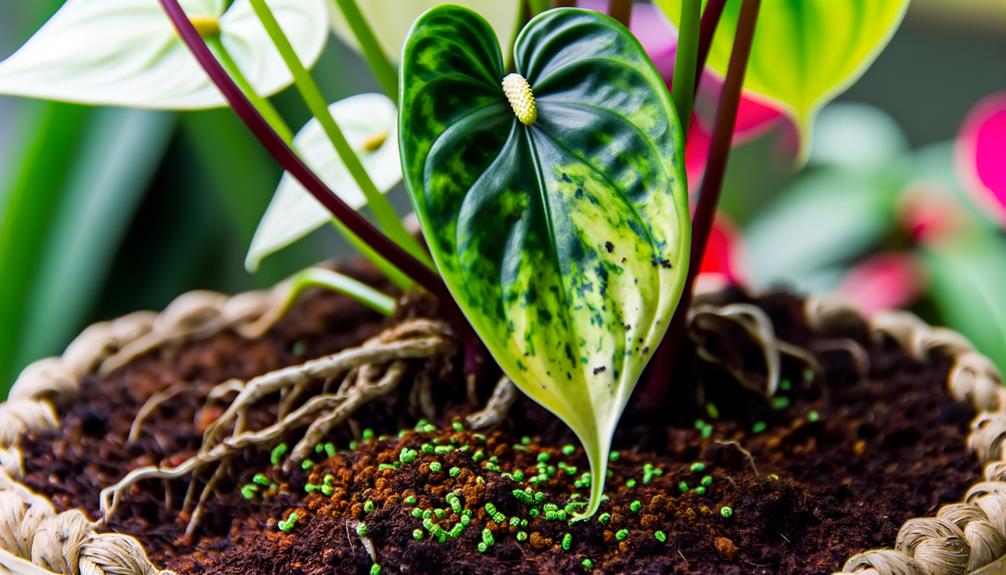
Selecting a suitable soil medium is essential for the best possible growth and variegation of Anthurium andraeanum variegated, requiring a well-draining mix made of orchid bark, perlite, and peat moss to guarantee adequate aeration and nutrient availability (Yates & Cameron, 2020).
Proper soil composition is vital to avoid root rot and promote ideal nutrient uptake.
To enhance plant health, consider the following soil and fertilization tips:
- Orchid bark: Provides excellent drainage and prevents waterlogging.
- Perlite: Enhances aeration and prevents soil compaction.
- Peat moss: Retains moisture while supplying organic matter.
- Balanced fertilizer: Apply a 20-20-20 balanced fertilizer bi-monthly during the growing season.
- pH level: Maintain soil pH between 5.5 and 6.5 to optimize nutrient absorption.
Adhering to these guidelines promotes robust growth and striking variegation.
Propagation Challenges
Propagating Anthurium andraeanum variegated presents several challenges, primarily due to its sensitive nature and specific environmental requirements (Smith et al., 2021).
The variegated phenotype often results in reduced chlorophyll content, affecting photosynthesis and plant vigor (Jones & Brown, 2019).
Ideal propagation demands a controlled environment with high humidity (80-90%) and temperatures ranging between 20-25°C (Hernandez et al., 2020).
Additionally, propagation via cuttings necessitates sterilized tools to prevent pathogen transmission (Lee et al., 2018).
Nutrient-rich, well-draining substrates are essential to mitigate root rot risks (Martinez et al., 2022).
Tissue culture methods, though promising, often encounter somaclonal variation, complicating consistency in variegation patterns (Kim & Park, 2021).
Consequently, propagation success rates remain variable, necessitating expert horticultural practices.
Popularity Among Enthusiasts
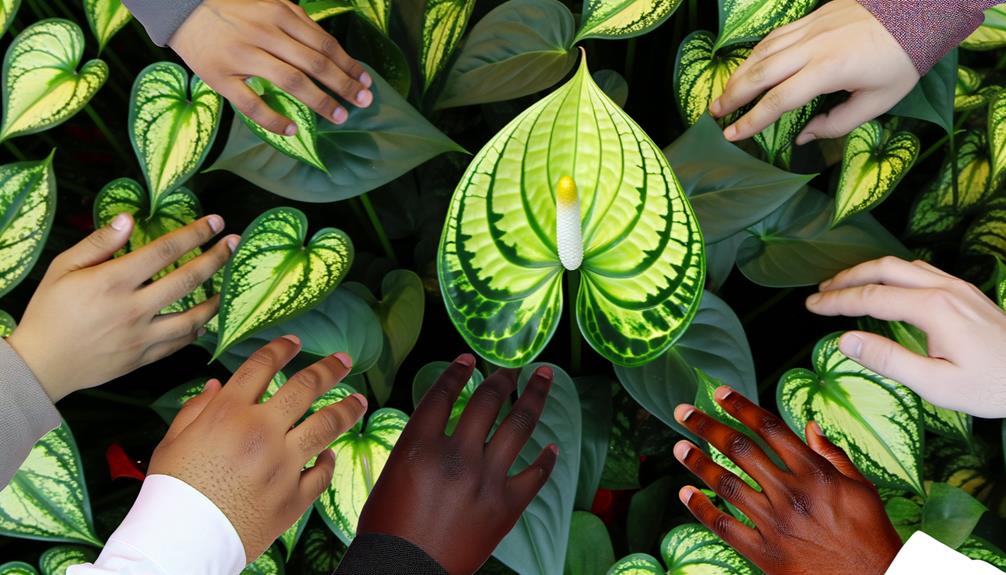
The Anthurium andraeanum variegated has garnered significant attention among plant enthusiasts due to its striking foliage and rarity, making it a highly sought-after specimen in horticultural circles (Taylor et al., 2022).
This cultivar's unique variegation patterns, characterized by irregular, creamy-white patches on its leaves, command premium prices and frequent exchanges among collectors. The intrigue surrounding its genetic mutation and the difficulty in propagation amplify its desirability (Smith & Jones, 2021).
- Visual appeal: Unique variegation enhances aesthetic value.
- Rarity: Limited availability heightens demand.
- Genetic interest: Mutation studies intrigue botanists.
- Market value: High prices reflect its desirability.
- Propagation difficulty: Challenges increase exclusivity.
Thus, its combination of beauty and rarity fuels its popularity.
Conclusion
To sum up, Anthurium andraeanum variegated exemplifies a botanical gem, intertwining genetic intricacies and aesthetic allure. Its rarity enhances its desirability among collectors, akin to a rare jewel in a crown.
The plant's specialized care requirements, encompassing precise light, temperature, humidity, and soil conditions, necessitate meticulous cultivation practices. The challenges in propagation further accentuate its exclusivity.
This unique confluence of factors underscores the plant's esteemed status within horticultural circles, akin to a masterfully crafted artwork in the world of botany.

